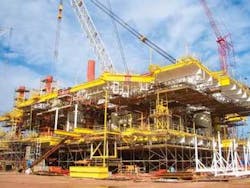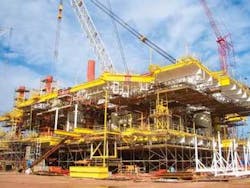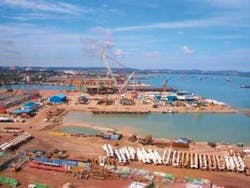Batam yard expands to meet demand
PT McDermott Indonesia (PTMI) is positioning its 110-ha Batam yard for the next wave of engineering and fabrication work, having committed $20-$25 million for upgrading facilities.
PTMI president Steven W. Roll cited a strong upturn in global upstream projects, having almost completed two large-scale projects, one CPP platform for the Arthit field in the Gulf of Thailand and the second, an onshore LNG plant for Australia.
He highlighted the challenges of meeting demand from global oil and gas projects, and pointed to Batam’s proximity to aggressive new energy projects in the Asia-Pacific region.
McDermott has sharpened its tools, he said in a speech at the Batam yard during the visit of Indonesian President Susilo Bambang Yudhoyono earlier this year.
“We have spent more than $10 million on the barge,Intermac 650, which would be used for delivering and installation of large projects, especially decks weighing 20,000-25,000 tons,” he said. He also expects some installations to weigh up to 30,000 tons.
Roll said that deepwater development requires large-scale platforms.Intermac 650 is the heavyweight of McDermott’s fleet of barges and was redesigned recently to offer a complete float over and installation package.
Another $15 million is scheduled for spending in 2006-2007 on equipment, workshops, and plants at the Batam yard, which is being boosted to become an 8 million craft man-hours work yard, up from about 3 million man hours in the late 1990s.
The Batam yard is adding a second project-specific skidway, having completed one recently.
“We have refurbished all the buildings at the yard and increased capacities at workshops for pipes, structural work, NDT, and painting,” Roll said. “We now have a modern system in place and we like to be in control of the projects.”
“We see a lot of opportunities and a lot of inquiries from new projects, and our engineering teams are already working on initial planning of some of these projects.”
McDermott is set to double its engineering capacity. “We are recruiting personnel and aims to double our 100+ engineers in the Jakarta office,” he said.
The Singapore office restarted earlier this year, and at least 40 more engineers will join the 80-engineer strong regional center, McDermott’s link in planning, designing and implementing projects.
“The Indonesian and Singapore offices are the driving force for McDermott,” Roll said.
Manpower at the Batam yard is scheduled to increase to 6,000 by the end of this year from 4,700 at present.
“This should reflect how busy we are,” he said, pointing out that 400 engineers were already on site at the Batam yard.
Roll keeps his expectation conservative, looking ahead to stay busy for the next three to five years. He also remains cautious in projecting volume of new projects.
But first steel was cut in June for two major Southeast Asian projects - Indonesia’s Kerisi field CPP jacket, module, pipeline, and other support structures, and the CPP jacket for Vietnam’s Su Tu Vang field.
“We take a complete contract at McDermott and our focus will continue to be on heavy weight projects in line with our philosophy of delivering on schedule and on budget,” he said.
He pointed out that Batam was a self-performing yard, set to execute more than 8 million craft man-hours this year. “We have executed approximately 4 million craft man-hours this year, up to now.” In the late 1990s, it had doubled craft man-hours capacity to three million.
In a way McDermott is an Indonesian corporate citizen with 98% of its workforce being Indonesians. But it is also a global player with international projects and draws on expertise and skill of regional engineers. It is a multi-national organization, said Roll, adding that 55% of McDermott’s contracts were for international projects, which makes McDermott an export-oriented engineering house.
The Arthit project, the fifth train for Australia’s LNG project, and Su Tu Vang are major Southeast Asian developments, while Kerisi is a challenging Indonesian project off Kalimantan, Borneo.
With the anticipated flow of new projects, PTMI will step back to determine how these contracts will be fulfilled. The contracting environment is equally challenging with the costs of materials going up and an increasing manpower shortage, he said.
McDermott has signed a memorandum of understanding with Batam Polythenic to train future professional and skilled workers for the oil and gas industry. The gap between young and older people in the industry has widened. “The biggest challenge is to find experience people for the projects,” Roll said. Roll noted that McDermott has recalled retirees. “We have taken on fresh graduates from Indonesia, China, India, Vietnam, Malaysia, and Thailand to boost our work force and capabilities.” These young professionals are working with experienced employees while the retirees serve as supervisors.
Having come back from a slowed down pace of work in the past few years and re-opened Singapore office, McDermott has started working on strategies. Roll sees the possibilities of strategic alliances with Asian yards to implement some of its projects.
One example is the recent cooperation on a project in the South China Sea. It had deployedIntermac 650 for installation of the jacket in the Panyu field.
Gurdip Singh, Special Correspondent
PTMI projects at mid-year 2006:
● North West Shelf Venture’s Phase V LNG Expansion Project for Australia’s Woodside Energy Ltd. It has a $77 million contract for construction engineering, procurement, fabrication, assembly, and erection of the pre-assembled module and pipe rack units totaling nearly 20,000 metric tons. Seventy-seven completed modules and pipe racks will be shipped from the Batam fabrication yard to Dampier in Western Australia, and transported to the Venture’s LNG facilities on the Burrup Peninsula where the new LNG “Train V” is being constructed. Structural fabrication work on the project began in October 2005, with piping fabrication in January 2006. The project is expected to be completed in 2Q07.
● Phase III A, Arthit CPP complex topsides - APP topsides. It secured a $110 million contract in 2005 from Thailand’s PTT Exploration & Production Public Co. Ltd. APP is part of the Arthit Field Development Project in the Gulf of Thailand, 250 km northeast of Songhkla and 35 km east of the existing Bongkot field. The group is undertaking procurement, fabrication, transportation, installation, hook-up, and pre-commissioning of the APP topsides, equipped with production and processing facilities, weighing approximately 16,000 metric tons. First steel was cut and fabrication work began in July 2005. Offshore installation of the structure will be performed using float-over technology. The group’s vessels *I*Intermac 650*I* and *I*DB30*I* will perform the transportation and installation. Construction engineering of the deck is under way at Batam; installation engineering will be performed by the Jebel Ali-based marine group, and engineering for the float-over component design will be executed by the company’s Houston office. It will also handle fabrication and transportation of the 4,759-metric ton, eight-leg jacket for the Arthit Processing Platform (APP). Fabrication is expected to be completed in 3Q06.
● The group started this year on the Kerisi Central Processing Platform substructure and bridge. Some $20 million was secured this year for the project. The CPP substructure weighs over 7,600 metric tons. The project is part of the ongoing development of the Kerisi and Hiu fields in the Indonesian sector of the Natuna Sea. The group will fabricate the 3,600 metric ton CPP jacket along with piles weighing 2,600 metric tons, a module support frame of 1,400 metric tons, and a bridge connecting to the wellhead platform. Work on the project began in May 2006 including construction engineering and procurement from the group’s Asia Pacific fabrication yard and marine base in Batam. First steel was cut in June. Overall, project completion is scheduled for 2Q07.
● Su Tu Vang CPP PFM/Pipelines - central processing and production platform, and infield pipelines. McDermott won a contract this year from Vietnam’s Cuu Long Joint Operating Co. to provide engineering, procurement, construction, installation, hook-up, and commissioning services for a central processing and production platform with an integrated 14,900 metric ton deck, and associated infield pipelines for the Su Tu Vang field, offshore Vietnam. Contracts of this type typically are valued at several hundred million dollars. The integrated CPP platform, to be installed in about 53 m of water, includes a 14,900-metric ton float-over deck, a 3,940-metric ton, eight-legged jacket, and piles weighing 3,800 metric tons. Work on the project started in March 2006 when the group began engineering and procurement activities from its project office in Singapore. The deck float-over, jacket and in-field pipeline installation will be performed by the group’s in-house float-over and launch barge and combination derrick. In addition, the group will also undertake EPCI services for several pipelines and pipeline end manifolds including a 24-in. three-phase production pipeline measuring over 7 km, one 6 km by 16-in. diameter water injection pipeline, a 10-in. lift gas pipeline, 6 km long, a 2.4 km by 3-in. fuel gas pipeline, and one composite power and communications submarine cable between CPP and an existing wellhead platform WHP-A. The work also includes modification of the existing WHP-A platform, including the provision of a deck extension and installation of a riser and J-tube. Project completion is scheduled for 2Q08. The last major Indonesian project on Batam was theBelanak FPSO in 2004. McDermott fabricated and integrated the more than 25,000-metric ton FPSO topside modules on to the Belanak, making it the world’s first FPSO-based LPG plant with capacity to process 350 MMcf/d of gas for export, up to 100,000 b/d of oil and condensate, and up to 23,000 b/d of LPG.


